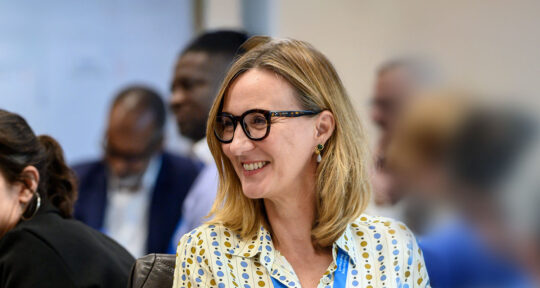How to apply the McKinsey 7-S Model in your organization
Aligning strategy with structure, people, and culture is a common challenge for senior executives—especially in times of rapid change. As organizations grow or evolve, even strong strategies can fail if internal elements aren’t aligned. When teams, systems, or leadership styles are out of sync, the result is often inefficiency, confusion, or stalled progress.
The McKinsey 7-S Model helps leaders make sense of this complexity. It was developed by McKinsey consultants Tom Peters and Robert Waterman and introduced in their 1982 book In Search of Excellence. The model marked a shift in how people thought about organizational effectiveness.
Instead of focusing only on structure—who reports to whom, who does what—it identifies seven interdependent elements that shape performance. By emphasizing coordination over hierarchy, the 7-S framework offers a more complete view of how organizations function. Decades later, it remains a valuable tool for driving change and aligning teams.
In this article, we’ll explore how to apply the McKinsey 7-S Model in your organization, with examples, practical tips, and insights tailored for senior leaders.
- What is the McKinsey 7-S Model?
- The 7 elements of McKinsey’s framework
- Why use the McKinsey 7-S Model?
- Steps to implement the McKinsey 7-S Model
- Success story: how Starbucks brings the 7-S Model to life
- Why alignment is your strategic advantage
What is the McKinsey 7-S Model?
The McKinsey 7-S Model is a strategic framework used to analyze and align an organization’s internal elements. It shows how seven interconnected factors—Strategy, Structure, Systems, Shared Values, Skills, Style, and Staff—must work together to enable effective change and long-term success.
If you’ve ever asked yourself how to think strategically, the answer begins with cultivating awareness, curiosity, and a willingness to challenge conventional thinking. It blends creativity with logic and encourages leaders to move beyond short-term problem solving to adopt a broader, more proactive approach.
Strategic thinking is not limited to isolated decisions; it is a continuous mindset that shapes how leaders evaluate situations, allocate resources, and set priorities over time. It requires balancing immediate demands with future opportunities, ensuring that every action taken today is aligned with a longer-term vision.
Leaders who cultivate strategic thinking are better equipped to navigate uncertainty, adapt to evolving environments, and drive sustainable growth for their organisations.
Designed for managing complexity, it helps leaders identify misalignments and guide transformation efforts.
These seven key elements can be grouped into two categories: hard elements, which are more tangible and easier to define; and soft elements, which are more intangible but equally critical to success.
HARD ELEMENTS | SOFT ELEMENTS |
Strategy | Shared values |
Structure | Styles |
Systems | Staff |
Skills |
The 7 elements of McKinsey’s framework
Let’s take a closer look at each of the seven:
1. Strategy
The long-term plan an organization uses to gain and maintain competitive advantage. A strong strategy sets direction and guides decision-making across all departments. For the model to work, this strategy must align with the other six elements.
2. Structure
The way roles, responsibilities, and reporting lines are organized. A clear structure helps people understand how work flows and who makes decisions, supporting better coordination and accountability.
3. Strategy
The formal and informal processes that keep the organization running. These include everything from daily operations to performance reviews and internal communication tools. Systems translate strategy into action.
4. Shared Values
The core beliefs and norms that define the organization’s culture. They sit at the heart of the 7-S Model and shape behavior, motivation, and decision-making at every level.
5. Style
The way leaders behave and influence others. Style reflects the tone set by top management—whether collaborative, directive, hands-off, or something else—and impacts trust, morale, and communication.
6. Staff
The people who make up the organization. This element looks at team size, capabilities, and how people are hired, developed, and retained. It also considers motivation and engagement.
7. Skills
The actual competencies and capabilities within the team. What people know how to do—and how well they do it—affects performance, innovation, and adaptability. Identifying and closing skill gaps is critical for growth.

Why use the McKinsey 7-S Model?
Many organizations focus solely on strategy and structure during times of change. However, ignoring soft elements like culture, leadership style, and skills often results in poor execution or internal resistance.
The 7-S Model emphasizes interdependence.
For example:
- A shift in strategy (e.g., digital transformation) requires updating systems (like new tech platforms), reskilling staff, and fostering a culture (shared values) that embraces change.
- If you restructure your org chart (structure) but don’t update performance management systems (systems) or leadership behaviors (style), you may see confusion or friction.
This makes the McKinsey framework especially useful for change management, strategic thinking, and long-term organizational design.
The 7-S Model helps leaders see the bigger picture. It reveals how strategy, systems, and people are connected—and what happens when they aren’t. By offering a clear view of these internal relationships, it supports more informed decisions and smoother execution.
It’s especially valuable during times of change. Whether you’re navigating a merger or adjusting your strategy, this framework helps you stay focused and coordinated across teams.
Most importantly, it supports strategic thinking by encouraging leaders to consider both tangible and intangible factors when driving performance.
Steps to implement the McKinsey Model
Implementing this model involves a systematic approach to identify gaps, align processes, and ensure that all elements work harmoniously towards the organization’s goals. Below are the essential steps to successfully implement the McKinsey 7-S Model:
1. Start with shared values
Clarify what your organization truly stands for.
In the 7-S framework, shared values sit at the center of the diagram—and for good reason. They influence every other element. Before redesigning strategy or structure, clarify what your company stands for:
- What beliefs drive decision-making?
- What does success look like for your team?
- Are these values consistent across leadership and staff?
For example, a global consumer goods company re-evaluating its sustainability strategy might start by revisiting its core value of “responsible growth”—ensuring it’s not just a slogan but reflected in hiring practices, supplier policies, and performance incentives.
2. Map the current state of the remaining elements
Review how the six remaining elements are functioning today.
After defining your organization’s shared values, the next step is to assess how the other six elements currently operate. This gives you a baseline for identifying misalignments and areas for improvement.
Use guiding questions like:
- Strategy: Is our strategic direction clearly defined and understood?
- Structure: Does our organizational design support that strategy?
- Systems: Are our core processes efficient and scalable?
- Style: What leadership behaviors are shaping our culture?
- Staff: Do we have the right people in key roles?
- Skills: What capabilities do we have—and what’s missing?
You can gather this information through internal workshops, leadership interviews, and employee surveys.
3. Spot the misalignments
Identify gaps, frictions, or inconsistencies.
Once you’ve assessed each element, the next step is to look for areas that don’t line up. Misalignment often explains why execution fails—even when the strategy seems sound.
Some common warning signs:
- Your structure supports speed, but your systems are slow and manual.
- Your strategy promotes innovation, but leadership discourages risk.
- You hire for collaboration, but incentives reward individual performance.
Some examples would include:
- A healthcare company wanted to improve patient satisfaction. Their strategy focused on personalized care, but their systems prioritized speed over quality, and frontline staff felt unsupported. These gaps made it hard to deliver on their vision.
- A fast-growing fintech startup realized its strategy was focused on rapid international expansion, but its structure was still based on local silos with duplicated efforts. It also lacked the systems to scale onboarding and compliance efficiently.
Misalignments aren’t always obvious. That’s why this step benefits from cross-functional workshops and honest internal feedback.
4. Define your desired future state
Envision how each element should look to support your goals.
Now that you know what’s out of sync, it’s time to design what good looks like. Picture how each element should operate in your ideal organization.
You might ask:
- What kind of skills will we need to grow?
- How should leadership behave to support our values?
- Do our systems make work easier—or harder?
- Is our structure helping or slowing things down?
This vision acts as your target. It doesn’t have to be perfect, but it should be consistent.
Tip: Map your current and desired state side by side. This makes the gaps visible and helps prioritize change.
5. Prioritize and act
Outline the steps, timelines, and responsibilities for change.
With your future state in mind, start planning strategically how to get there. Focus on the most urgent or high-impact misalignments first.
A solid action plan includes:
- What needs to change (e.g., systems, reporting lines, team structure)
Who is responsible for each task - How progress will be tracked
- A timeline with realistic milestones
For example, a retail company realized their style (top-down leadership) was blocking innovation. They designed leadership training and restructured teams to encourage autonomy. Over six months, engagement scores improved and experimentation increased.
6. Monitor and adjust
Monitor impact and revisit the 7-S regularly.
Organizational alignment is not a one-time task. As the market evolves and your strategy shifts, revisit the 7-S framework periodically. Continuous feedback loops, such as employee engagement surveys or KPIs tied to strategic outcomes, can help monitor alignment over time.
Success story: how Starbucks brings the 7-S Model to life
To better understand how the McKinsey 7-S Model works in practice, let’s look at Starbucks. The global coffee brand is known not just for its products, but for the consistent experience it delivers across thousands of locations worldwide. Here’s how each of the seven elements plays out in its organization:
TECHNIQUE | BEST USE CASE | GROUP OR SOLO? | REQUIRES FACILITATOR? |
Classic brainstorming | Early ideation with open-ended goals | Group | Yes |
Reverse brainstorming | Challenging assumptions or blockers | Group or solo | Optional |
Brainwriting | Avoiding groupthink / introvert-friendly | Group | Yes |
SCAMPER | Reframing existing ideas or products | Solo or group | No |
Role storming | Encouraging out-of-the-box perspectives | Group | Optional |
Why alignment is your strategic advantage
Using the McKinsey 7-S Model isn’t about following a checklist—it’s about asking the right questions, listening across the organization, and being willing to realign when needed. Done well, it creates the foundation for resilient, agile organizations that can adapt and lead with clarity.
At IMD, executives from around the world use frameworks like the McKinsey 7-S Model to challenge assumptions, refine strategies, and drive meaningful change in their organizations. If you’re ready to deepen your strategic capabilities, explore IMD’s Strategic Thinking Program and learn alongside a global community of leaders.
Throughout the program, you’ll learn how to assess your organization’s challenges, make better trade-offs, and turn insight into actionable initiatives. You’ll explore how to connect strategy with culture and how to adapt your thinking in fast-changing environments. With personalized coaching and peer discussions, you’ll gain the tools and confidence to lead with clarity and purpose—no matter what lies ahead.
Ready to take the next step? Explore the Strategic Thinking program and join a global network of leaders shaping the future of business.
Stay up to date 💌
Join the IMD Community.
Stay informed with our latest insights on leadership, strategy, digital transformation and more. Explore fresh perspectives from IMD business school to help you navigate today’s complex business landscape.




